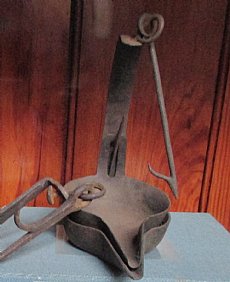Cruisie lamp in Dunrobin Castle Museum
10 April 2021
- News Type:
- Find of the Month

Cruisie (or crusie) lamps were formed of two boat-shaped iron bowls placed one above the other. Oil, often from fish, sea bird, seals or whales in coastal regions, dripped from the top bowl into the larger smaller one, lit by a wick placed in the spout. The result was a smoky, unsteady flame, with the wick needing constant attention and trimming. Notches on the projecting bar of the upper shell ensured that the oil stayed relatively level. The lamps were designed to be suspended on a wall, sometimes with elaborate wall spikes. This example is in Dunrobin Castle Museum, and is likely to be from Sutherland.

© Anne MacInnes
Cruisies are often dated to the 18th century, though examples are likely to be older and later. Also at Dunrobin Castle Museum is a stone mould for manufacturing the lamp bowls, suggesting that lamps would have been made by local blacksmiths. Some cruisie lamps are also known of copper and brass.
Although thought to originate in Scotland, these lamps were widespread in Scotland and further afield. They were replaced later by tin lamps, often produced by Highland Travellers, or the coming of electricity.
A number of superstitions revolved around cruisie lamps. A blue flame was said to foretell that the next day would be windy, while a green flame indicated a witch present. A spark meant that news was coming to the person in the direction the spark flew.
Further information
Goudie, Gilbert 1888 ‘The Crusie, or ancient oil lamp of Scotland’, PSAS 22 (1887-1888), 70-78 (available online from http://journals.socantscot.org/index.php/psas/issue/view/151
Grant, I F 1961 Highland Folk Ways, Routledge and Kegan Paul: London.
Find of the Month Archive
- 25/07/2022 Steatite Vessels
- 10/04/2021 Cruisie lamp in Dunrobin Castle Museum
- 02/03/2021 Medieval Sword Pommel from Sleat, Skye
- 01/02/2021 Hilton of Cadboll Pictish Cross Slab
- 04/01/2021 Gunflint from Stoneyfield, Inverness
- 02/12/2020 Bobbin from Contin Bobbin Mill
- 02/11/2020 Russian Lead Cloth Seal from Cromarty
- 01/10/2020 The Poolewe Hoard
- 04/09/2020 Storr Rock Viking Silver Hoard
- 07/08/2020 Mesolithic bloodstone artefacts from Camas Daraich, Skye
